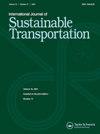Can shared micromobility replace auto travel? Evidence from the U.S. urbanized areas between 2012 and 2019
IF 3.1
3区 工程技术
Q2 ENVIRONMENTAL STUDIES
International Journal of Sustainable Transportation
Pub Date : 2023-12-01
DOI:10.1080/15568318.2023.2179444
引用次数: 0
Abstract
Previous literature has shown mixed findings on whether bike or e-scooter share programs, collectively called shared micromobility, play a role in reducing vehicle travel. In this study, we focused on two types of shared micromobility (i.e., bikes—both regular and e-bikes—and e-scooters). We examined their impact on vehicle travel in urbanized areas in the United States between 2012 and 2019. Employing the difference-in-differences (DID) approach, we quantified the collective effect of shared micromobility on daily vehicle miles of travel (VMT) per capita at the urbanized area level. Our findings suggest that bike shares could reduce VMT while e-scooter share alone might not have a significant impact on lowering vehicle travel. Our results also indicate that there may be a synergistic effect of bike and scooter shares in VMT reduction when both types of shared micromobility are available in an urbanized area. Our findings also demonstrate regional variations in the impact of shared micromobility on vehicle travel.
共享微出行能取代汽车出行吗?来自2012年至2019年美国城市化地区的证据
本文章由计算机程序翻译,如有差异,请以英文原文为准。
求助全文
约1分钟内获得全文
求助全文
来源期刊
CiteScore
8.90
自引率
2.60%
发文量
56
期刊介绍:
The International Journal of Sustainable Transportation provides a discussion forum for the exchange of new and innovative ideas on sustainable transportation research in the context of environmental, economical, social, and engineering aspects, as well as current and future interactions of transportation systems and other urban subsystems. The scope includes the examination of overall sustainability of any transportation system, including its infrastructure, vehicle, operation, and maintenance; the integration of social science disciplines, engineering, and information technology with transportation; the understanding of the comparative aspects of different transportation systems from a global perspective; qualitative and quantitative transportation studies; and case studies, surveys, and expository papers in an international or local context. Equal emphasis is placed on the problems of sustainable transportation that are associated with passenger and freight transportation modes in both industrialized and non-industrialized areas. All submitted manuscripts are subject to initial evaluation by the Editors and, if found suitable for further consideration, to peer review by independent, anonymous expert reviewers. All peer review is single-blind. Submissions are made online via ScholarOne Manuscripts.

 求助内容:
求助内容: 应助结果提醒方式:
应助结果提醒方式:


